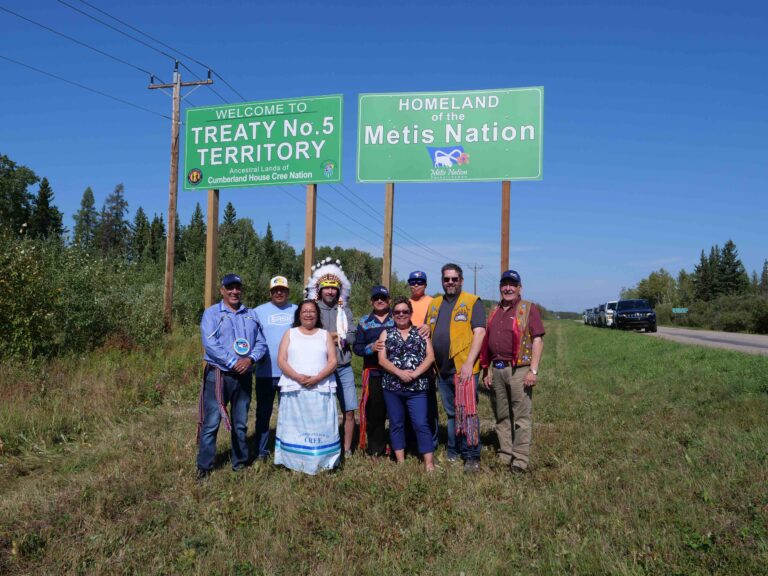
Members of Métis Nation–Saskatchewan (MN–S) and Cumberland House Cree Nation (CHCN) gathered at the E.B. Campbell Dam entrance on Highway 123 where a welcome sign to Treaty 5 Territory and the Metis homeland was once ridden with bullet holes.
The sign welcoming visitors to Treaty 5 Territory, initially erected this summer, was vandalized and then disappeared altogether.
Two signs now stand at Highway 123. One for the Métis Nation and one for Treaty 5 territory and the ancestral lands of Cumberland House Cree Nation.
Chief Rene Chaboyer and MN-S President Glen McCallum placed new signs recognizing the heartland of the Métis Nation and welcoming people to Treaty 5 territory, ancestral lands of Cumberland House Cree Nation.
The gathering was to solidify the bond between First Nations and Metis people of the Saskatchewan River Delta.
Chaboyer said the location is also a reminder of the colonization of Indigenous people and the detrimental impact that the E.B. Campbell Dam on his people’s way of life.
Chaboyer said the dam prevents water and essential nutrients from reaching his community, leading to water access problems in one of the most water-rich areas of Saskatchewan and Canada.
“At the end of the day they still hold back and choke out as much water as they can… It holds back a lot of sediment that is required for the delta to survive, meaning it’s almost like vitamins are being held back,” Chaboyer said.
“The sediment feeds all the plants, the birds and animals live off, then our people utilize the delta upstream from the dam which provides the food for us, our way of life, our medicine to grow.”
McCallum said Métis and First Nations people have a long history of working and living together in Treaty 5 territory.
“We have always had a strong working partnership with our First Nations brothers and sisters in this province,” McCallum said.
“In honour of that, we enter into an official nation-to-nation partnership that gives us a unified voice when it comes to exercising our rights as both distinct peoples Métis and First Nations in Treaty 5 territory.”
Barry Carriere, whose father James was a Métis Nation leader, watched as the two leaders erected signs marking the shared territory.
“This is what I’ve been longing to do. We are all one. We need to form an alliance to work together, for our future, for our children,” Carriere said.
MN–S and CHCN are committing to come together on economic development, governance, and resource sharing issues.
“Like other communities in the province, these signs welcome visitors to the region but also remind people they are entering a traditional area,” Chaboyer said.
“The signs symbolize the partnership between CHCN and MN–S to work together to push our Indigenous rights and our culture. This relationship just makes sense.”
